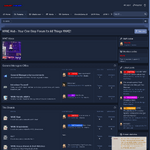In my previous article, I briefly touched on the idea that emotion leads to action. That's all fine and dandy for web designers, but what about managers looking to understand and motivate their employees? How about freelancers looking for clients or business owners looking to make a deal with other businesses? In order to do this effectively, we need to get a quick check on what emotions are driving your actions, and what emotions are driving your potential clients or employees and their actions.
The reason why is pretty obvious: emotional rejection is painful, and it's a painful distraction when you're trying to get work done. If your emotion is rejected by your client, your actions are rejected by your client and your motivation to continue sinks. It's not that you have no motivation: it's that your motivation is being rejected. You don't have an undermotivated or underperforming employee as much as you have a misunderstood and underappreciated one.
We also need to sort out the emotions that make people take action versus the ones that don't. Anxiety, for example, frequently leads to paralysis. Trauma leads to chaos, and sadness leads to the desire to comfort or be comforted. These emotions are unlikely to drive productivity or take constructive action to grow a business. Discouragement and despair aren't good for the work speed either. So what makes us work?
Anger, hatred, competitive spirit, passion, desire to be the best, triumph, misery, and distress
Sometimes, things just suck. They aren't right, an inconvenience, a bother, a danger, a hazard. The first response humanity had to the fact that life isn't perfect is to get angry at it, to demand a solution, and that the solution be made NOW. All of us, at one point or another, will find ourselves with our back against the wall in a tight squeeze needing stuff to happen right away to fix our problem. This problem is unacceptable. This situation is unacceptable. It's not a good enough. And we're not going to put up with it anymore.
Some people are more inclined to become angry in response to their problems. All they need is a tight deadline and a fire-breathing boss, and they are ready to go. Their competitors are eating their lunch for every second they delay. This needs to be done NOW. Go, go, go! And they do.
Western cultures are driven by anger as a matter of course. Everything is a competition: a business fights to become the highest valuation. A politician beats down others in an election. Competitive sports: beating the losers. Making sure your weapons stockpile is bigger than the other guy. For better and for worse, our anger drives us - to compete, to be better, and to win. And to some extent, we all do - anger has made us better and better technology in our desire to subdue nature for our comfort and health. That is where this motivation excels: it allows us to subdue the complex and imperfect world we live in and destroy the thorns and thistles.
Calm, peace, compassion, harmony, quality, craftsmanship, and stability
And then there are the artists, the religious vocations, and the mediators. The people who dispense wise proverbs and the people who take 10 years to make one calligraphy brush. Unlike the anger-driven problem solvers who must have it all done right away in a factory with mass production at high speed, the artisans value stability and quality, a sense of self and a life free from disruption. This is a more Eastern form of thought.
Most of us eventually arrive at a place where we want stability and connection with people more. Anger can take care of our basic needs, but that is not the only problem that humanity faces. We also struggle with understanding and connecting with each other, and crafting and making art, investing in things that take weeks, months, and years to accomplish, is a way of building a life and legacy.
Some of us, of the naturally artistic temperament, however, must weather cultural stigma in order to get anything done. Anger-motivated people inflict deep emotional wounds that come out as art. They are motivated by building connections between people, but then must live in a world of competition and destruction. Eventually, these will find a place of safety, hopefully, where they can work, and calming waterfalls and soothing structures to tap into.
Creativity, novelty, innovation, learning, excitement, growth, and change
Unlike the angry who crave the eradication of the wrong, and the calm who accept the right and wrong alike to simply express it, the creativity motivated person looks for the next new thing, the next right thing, the next thing to be excited about. This person wants to learn more about the world around them. The creative person wants more right - better, faster, stronger. But unlike the anger-motivated person who wants to BE the one to innovate in order to crush the other competitors, the creative person is happy to exult in other's creativity as well. They learn new innovations and improve on them. They are excited about human progress.
As such, they frequently move from subject to subject and project to project. This can rile anger-motivated folk who want things to get done instead of abandoned, and depress their artisan colleagues who want to focus on one thing for a long time and are left scratching their heads trying to understand.
In short, for work, humans are motivated by three basic things: problem-solving, connection and understanding between human beings, and a desire to better understand the world around us. All of us have the capacity for each of these, and it is these things that we work for, against the obstacles presented to us by the world and each other. However, most of us have different emotional motivations for each project that we take on. An anger-motivated person who wants the job done NOW will have little patience for the ruminations of the artisan or the happy lack of investment of the creative. Likewise, the artisan will find the anger-motivated person disruptive of the their contemplations and eager to cut corners on their craft. The creative will complain that the artisan's progress is too slow and suggest an alternative direction. All of this leads to burnout.
Understanding communication
First of all, the obvious advice need be stated - if you have an anger-motivated problem, assign it to an anger-motivated person. Trying to connect to a new customer base? Hire an artisan and be patient. Looking for someone to learn a complex problem and innovate a solution? Call the creative, but make sure they have enough variety within their current tasks that they don't end up doing something else on your dime.
But frequently, teams aren't hired for emotional compatibility. Assigning the large, complex projects to your more artisan-oriented employees will produce better results - they need the calm, peace, and stability of chewing on a single task for awhile. This will bore the creative who needs constant variety - assign all of the small and fun tasks to him instead. Someone who is motivated by calm and peace will come to you for advice and feedback as he or she needs as they refine their process - there is no need to nag them and that will make everything worse. The creative doesn't want supervision because his mind needs to be free to move - he needs to be guided rather than pushed.
Above all, never assume that your emotional motivation is the same as your bosses' motivation or your employee's motivation. This will reduce the pain of emotional rejection, and the blunt the long chain of emotional rejections that leads to burnout.
The reason why is pretty obvious: emotional rejection is painful, and it's a painful distraction when you're trying to get work done. If your emotion is rejected by your client, your actions are rejected by your client and your motivation to continue sinks. It's not that you have no motivation: it's that your motivation is being rejected. You don't have an undermotivated or underperforming employee as much as you have a misunderstood and underappreciated one.
We also need to sort out the emotions that make people take action versus the ones that don't. Anxiety, for example, frequently leads to paralysis. Trauma leads to chaos, and sadness leads to the desire to comfort or be comforted. These emotions are unlikely to drive productivity or take constructive action to grow a business. Discouragement and despair aren't good for the work speed either. So what makes us work?
Anger, hatred, competitive spirit, passion, desire to be the best, triumph, misery, and distress
Sometimes, things just suck. They aren't right, an inconvenience, a bother, a danger, a hazard. The first response humanity had to the fact that life isn't perfect is to get angry at it, to demand a solution, and that the solution be made NOW. All of us, at one point or another, will find ourselves with our back against the wall in a tight squeeze needing stuff to happen right away to fix our problem. This problem is unacceptable. This situation is unacceptable. It's not a good enough. And we're not going to put up with it anymore.
Some people are more inclined to become angry in response to their problems. All they need is a tight deadline and a fire-breathing boss, and they are ready to go. Their competitors are eating their lunch for every second they delay. This needs to be done NOW. Go, go, go! And they do.
Western cultures are driven by anger as a matter of course. Everything is a competition: a business fights to become the highest valuation. A politician beats down others in an election. Competitive sports: beating the losers. Making sure your weapons stockpile is bigger than the other guy. For better and for worse, our anger drives us - to compete, to be better, and to win. And to some extent, we all do - anger has made us better and better technology in our desire to subdue nature for our comfort and health. That is where this motivation excels: it allows us to subdue the complex and imperfect world we live in and destroy the thorns and thistles.
Calm, peace, compassion, harmony, quality, craftsmanship, and stability
And then there are the artists, the religious vocations, and the mediators. The people who dispense wise proverbs and the people who take 10 years to make one calligraphy brush. Unlike the anger-driven problem solvers who must have it all done right away in a factory with mass production at high speed, the artisans value stability and quality, a sense of self and a life free from disruption. This is a more Eastern form of thought.
Most of us eventually arrive at a place where we want stability and connection with people more. Anger can take care of our basic needs, but that is not the only problem that humanity faces. We also struggle with understanding and connecting with each other, and crafting and making art, investing in things that take weeks, months, and years to accomplish, is a way of building a life and legacy.
Some of us, of the naturally artistic temperament, however, must weather cultural stigma in order to get anything done. Anger-motivated people inflict deep emotional wounds that come out as art. They are motivated by building connections between people, but then must live in a world of competition and destruction. Eventually, these will find a place of safety, hopefully, where they can work, and calming waterfalls and soothing structures to tap into.
Creativity, novelty, innovation, learning, excitement, growth, and change
Unlike the angry who crave the eradication of the wrong, and the calm who accept the right and wrong alike to simply express it, the creativity motivated person looks for the next new thing, the next right thing, the next thing to be excited about. This person wants to learn more about the world around them. The creative person wants more right - better, faster, stronger. But unlike the anger-motivated person who wants to BE the one to innovate in order to crush the other competitors, the creative person is happy to exult in other's creativity as well. They learn new innovations and improve on them. They are excited about human progress.
As such, they frequently move from subject to subject and project to project. This can rile anger-motivated folk who want things to get done instead of abandoned, and depress their artisan colleagues who want to focus on one thing for a long time and are left scratching their heads trying to understand.
In short, for work, humans are motivated by three basic things: problem-solving, connection and understanding between human beings, and a desire to better understand the world around us. All of us have the capacity for each of these, and it is these things that we work for, against the obstacles presented to us by the world and each other. However, most of us have different emotional motivations for each project that we take on. An anger-motivated person who wants the job done NOW will have little patience for the ruminations of the artisan or the happy lack of investment of the creative. Likewise, the artisan will find the anger-motivated person disruptive of the their contemplations and eager to cut corners on their craft. The creative will complain that the artisan's progress is too slow and suggest an alternative direction. All of this leads to burnout.
Understanding communication
First of all, the obvious advice need be stated - if you have an anger-motivated problem, assign it to an anger-motivated person. Trying to connect to a new customer base? Hire an artisan and be patient. Looking for someone to learn a complex problem and innovate a solution? Call the creative, but make sure they have enough variety within their current tasks that they don't end up doing something else on your dime.
But frequently, teams aren't hired for emotional compatibility. Assigning the large, complex projects to your more artisan-oriented employees will produce better results - they need the calm, peace, and stability of chewing on a single task for awhile. This will bore the creative who needs constant variety - assign all of the small and fun tasks to him instead. Someone who is motivated by calm and peace will come to you for advice and feedback as he or she needs as they refine their process - there is no need to nag them and that will make everything worse. The creative doesn't want supervision because his mind needs to be free to move - he needs to be guided rather than pushed.
Above all, never assume that your emotional motivation is the same as your bosses' motivation or your employee's motivation. This will reduce the pain of emotional rejection, and the blunt the long chain of emotional rejections that leads to burnout.





